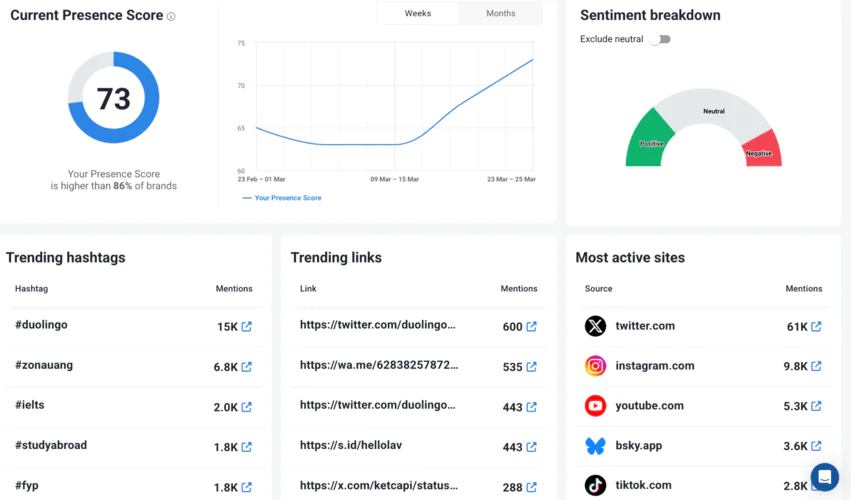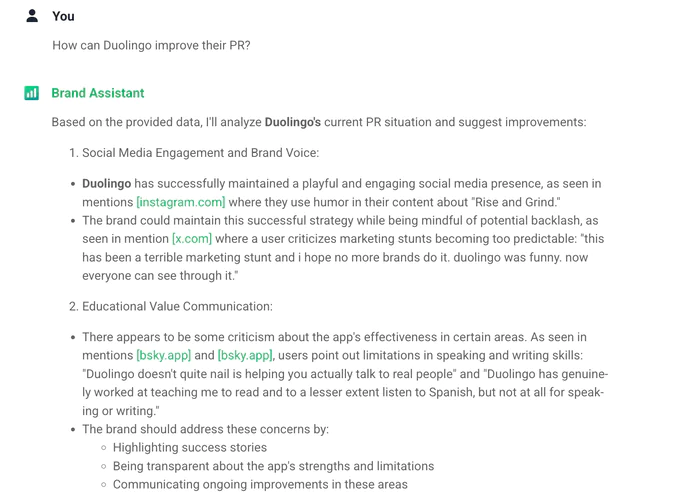How to Write a PR Report? Template & Example
Table of contents
PR professionals need a robust and affordable way to present the results of their work. Did all the press releases bring the desired impact? Did reaching out to influencers bring any substantial value? Did you achieve your PR KPIs? Here’s everything you need to know about PR reports.
The bottom line is simple — you must prove the value of your work to your supervisors. Are the numbers growing? Is your work affecting the company’s bottom line? This information is crucial for your CEO, CMO, and other PR pros you work with.
The solution? A PR report!
A PR report is a fundamental part of the industry. A well-researched and well-written PR report will help you make more insightful business decisions. It’s important to produce PR reports at timely intervals so you always have an overview of your current situation.
In this post, I will discuss the most efficient way to create a PR report.
Hopefully, at the end of this read, you will be able to prepare an informative quarterly PR report template that will bring your communications efforts to the next level.
Use Brand24 to generate your first PR report!
PR report template
AI tools can help you generate PR report templates within minutes.
And the best part? You can personalize them to your needs.
I created the reports below with a few clicks, and it took me about 5 minutes.
Feel free to download them and check what it looks like.
💡Click and download PR report templates:
⬇️ PR Report Template ( general analytics dashboard)⬇️
⬇️ PR Report Template (PDF)⬇️
⬇️ PR Competitor Comparison Report Template (PDF)⬇️
I didn’t apply any specific filters to them, but there’s a lot you can manipulate. For example:
- Sources included in the report
- The specific time frame
- The specific campaign overview
- & much more!
Plus, you can share this report with anyone you need with a simple link.
Generate your PR report using AI!
I honestly think it’s the best way to create a PR report!

Types of PR reports
The type of reports and the way you create them depends on the target audience.
Managers or clients need a different type of PR report than the board of directors or investors. Monthly and quarterly reports are the most popular, but there are more kinds!
Here’s a list of the most popular types of PR reports:
01 Monthly reports
Monthly PR reports will give you a general overview of the current situation of your brand. You can examine the effects of your work on the spot and your current media coverage, then adjust your activities accordingly. You can also reallocate your resources to the plan that brings the desired results.
🔎 Who is it for?
You should prepare monthly public relations reports for your direct supervisor or manager.
02 Quarterly reports
If the monthly report is a test, then the quarterly PR report is your end score. Quarterly reports will help you defend your results. You will be able to pinpoint the correlation between the dollars spent on your PR campaign and specific business outcomes. Even if you engage in activities that don’t directly link to sales, you can explain the benefits to the brand you manage.
🔎 Who is it for?
Quarterly reports are an interesting read for your VP, CMO, or Senior PR professionals.
Try AI-generated PR reports!
03 Annual reports
Annual reports are one of the most important PR reports you have to prepare. Your boss will make budget decisions based on the data you include in the annual report. If you need money for additional tools, new team members, or other resources, you should indicate it in the report. Don’t forget to mention the expected outcome of the spending.
🔎 Who is it for?
Annual PR reports contain information important for CEOs, the board of directors, or investors.
04 PR Campaign report
Before you launch a public relations campaign, you need to create reports, to define your goals. Your report will state whether you achieved your goal and what you should improve before the next campaign.
🔎 Who is it for?
You should prepare PR campaign reports for your direct supervisor or CMO. The audience of the report depends on the size of the campaign.
05 Crisis report
Every brand is prone to crisis. Thanks to the PR crisis report, you can show how your department helped minimize the damages, changed the narrative, and protected your brand reputation. It’s a great report to show off your PR efforts.
🔎 Who is it for?
Crisis management is an opportunity for PR managers.
Personalize your report to present your KPIs!
Manual PR reporting: 3 crucial steps.
Prefer to do your PR report manually?
Once you decide what type of PR report you want to prepare and who is the target reader, you can get to work!
Here’s a list of key points you may want to include:
01 Check the volume of mentions
The volume of mentions shows you how many times the name of your brand, product, or service has been used online.
In theory, the higher the volume of media mentions, the better recognition your brand has.

It’s important to start your PR analysis with the volume of media mentions.
A sudden spike in the number will indicate that your PR campaign is working. More and more people have heard about your company, so brand awareness levels are rising.
That’s exactly what you can see in the screenshot above. Duolingo did a campaign that went viral and created buzz all over the internet.
Check your volume of mentions!
02 Conduct sentiment analysis
Sentiment will give the context you need to assess the impact of your public relations communications on your brand.
The same sentiment analysis will tell you how people feel about your company. The tool uses NLP and AI-driven algorithms to determine whether the sentiment towards your brand is positive, negative, or neutral.
Sentiment analysis will help you spot any looming crisis and next steps to counteract the effects. The process helps determine the most successful content and, ultimately, helps increase reach.

Check how your PR efforts work!
03 Elaborate on your performance
Reach is the metric that highly determines your performance.
It’s particularly important for various PR agencies that need to work on media relations.

Discover our client’s success story — read the case study.
Brand24 calculates both social and non-social reach, so you get a ready-to-use analysis:

This analysis also shows how many people could have come into contact with your content.
From a PR perspective, reaching the right audience with the right message at the right time is a Holy Grail.
Try AI-generated PR reports!
PR report: What to include?
Apart from PR metrics, your PR report should include other important information.
The good news is, the structure of a report should remain the same for every PR industry. You can match the report and metrics with your PR strategy, to present the most actionable data.
What should a PR manager include in a report?
01 Summary
You will prepare a different PR report depending on your audience and organization structure. Whether your CEO, manager, or board of directors is reading the report, they need to see the most important insights and results.
That’s why you should always include a detailed brand coverage summary.
02 Benchmarks
For all the data you present in your PR reports, you need context. Choose the right benchmarks, both from your previous campaigns and your competitors’ numbers, to correctly interpret your data.
03 Competitive intelligence
Competitive intelligence is an integral part of an annual PR report. Competitive intelligence will illustrate your overall business presence and sentiment towards your brand. Competitive intelligence is particularly important for investor relations.
Get data for your PR report!
My tip: Use public relations software
Before you start any public relations campaign, you need to find the right public relations software.
An ideal tool will collect the data in real-time from various sources, including Web and social media platforms. Moreover, the media monitoring tool should provide insights into what your marketing and communications department could use to improve your existing public relations campaigns.
Implementing a social listening tool into your marketing and communications tool stack will automate most of the process.
For example, using Brand24, you can create reports with just a few clicks and get them emailed automatically for a pre-defined period. Life-saver!
Get automated PR reports!
Alternatively, you can try one of these PR monitoring tools.
Public relations analytics
Many public relations software will automatically analyze the collected social media mentions.
A robust analysis section will save you a lot of time, make the results of your PR campaigns more manageable, and bring your public relations efforts to the next level.
What should the perfect PR analysis contain?
- The volume of mentions
- Sentiment
- Reach, both for social media and Web sources
- Social media engagement
- The context of the discussion
- Fully customizable PDF reports
- Comparison of two or more media monitoring projects

Get all important PR data in one place!
PR data sources
Apart from the analysis part of the results, you need to take a look at the sources of the data.
Some PR tools will focus on social media channels, others will cover only Web sources. In my opinion, you should get data from all the sources, so that your marketing and communication could make the most informed decisions possible.
What results will Brand24 provide?
- Major social media platforms, including Facebook, Instagram, Twitter, Twitch, TikTok, and YouTube
- Publicly available Web sources
- Press releases
- Podcasts
- Newsletters
- News sites
- Blogs
- Review sites
- Forums
As you can see, Brand24 has a robust media coverage. This set of media monitoring data will help you make the most informed and insightful decisions for your organization.
Moreover, the data is collected in real-time, and email and in-app notifications will help you stay on top of everything.
Generate your PR report using AI!
PR report best practices
You already know a lot about writing a PR report — you know the possibilities of AI tools, that you need to define an audience and determine the type of a PR report, and have an overview of the key metrics that you need to track.
There are other PR reporting best practices and tips you should implement to succeed and show the ROI.
01 Clearly define the goals of the PR campaign
Your PR report will only be as good as your PR campaign. That’s why it’s crucial the clearly define the goals of the campaign before you start doing anything. In your reports, you need to present proof that your work is bringing substantial value to your clients’ businesses.
02 Public Relations KPIs
Before you start your PR reporting, you need to agree on key performance indicators with your client.
It’s important to be on the same page when it comes to KPIs so you can track the right metrics all the time. It’s important to start media monitoring before starting your campaign, as collecting historical data is expensive and not always accurate.
03 Visuals
The target audience of your reports is usually busy. To make your reporting more comprehensible, include some visual elements, for example, charts, graphs, or tables. Visuals will make it easier to prove the business value of public relations to the company.

Make your PR reporting effortless!
04 Write your recommendations
Preparing monthly reports gives you a unique competitive advantage. You have an overview of the data you can easily spot trends, identify the best performing content, and provide valuable feedback after special events and product launches.
That’s an opportunity to add a bit of investigative journalism to your work.
Spotting the insights allows you to provide valuable recommendations on adjusting your PR efforts to bring even more value to your marketing and communications efforts.
Plus, it doesn’t necessarily take much time. You can ask AI for recommendations based on your performance data:

Get AI recommendations for your PR report!
Conclusion
Hopefully, by now, you have all the information you need to write your public relations report and show the effects of your marketing and communications strategy on your business.
What should you take into account while preparing a report?
- Think about your audience. Who is going to read it? Your manager or one of the executives? Depending on what audience you choose, you will have to provide different pieces of information in your work.
- Agree on the business metrics and KPIs beforehand. You want to share the top news and show the value of your work. It’s hard to do when your executive or client focuses on different metrics.
- Choose a media monitoring tool. A well-chosen piece of PR software will help you get the information you need to boost your business and will save you a ton of time collecting and analyzing the results.
- Provide your business recommendations. That’s one of the most important parts of your PR journey.
Or you can simplify the process and generate a report using AI. Start with a Brand24 free trial and make PR reporting simple!
Related articles

![Everything You Need to Know about News Monitoring [2025]](https://brand24.com/blog/app/uploads/2024/04/news_monitoring_tools-1-600x335.webp)
![7 Steps for Effective PR Crisis Management in 2025 [Infographic]](https://brand24.com/blog/app/uploads/2024/04/PR_Crisis-600x335.webp)

![How to Measure PR Performance? [2025]](https://brand24.com/blog/app/uploads/2024/05/pr_performance-600x335.webp)

